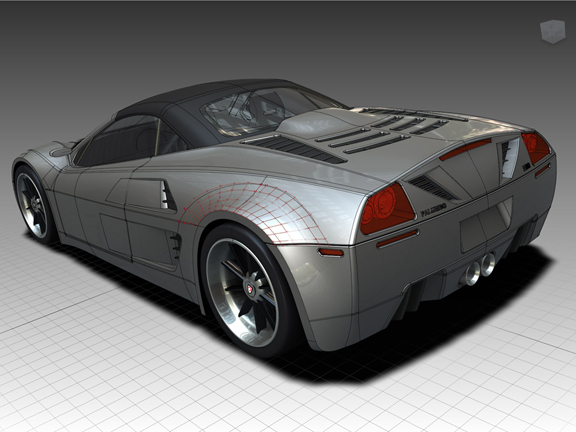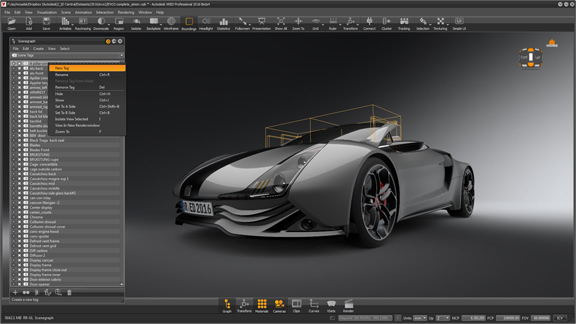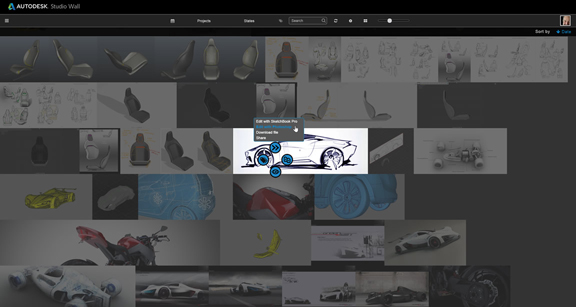
3D sculpting feature in Autodesk Alias 2017 (image courtesy of Autodesk).
Latest News
April 19, 2016
 3D sculpting feature in Autodesk Alias 2017 (image courtesy of Autodesk).
3D sculpting feature in Autodesk Alias 2017 (image courtesy of Autodesk). Visualizing automotive design in Autodesk VRED (image courtesy of Autodesk).
Visualizing automotive design in Autodesk VRED (image courtesy of Autodesk). Using visual thumbnails as the basis for data management in Autodesk Studio Wall (image courtesy of Autodesk).
Using visual thumbnails as the basis for data management in Autodesk Studio Wall (image courtesy of Autodesk).This week, Autodesk published a blog post announcing its strategy to cater to the auto industry with a bundle comprising Autodesk Alias, VRED, and Studio Wall. Simon Alford, senior manager of Automotive products at Autodesk, explained in the post that, “We are witnessing major shifts in the automotive world that have brought us, and the industry as a whole, to an important inflection point. Look at how companies like Uber and Lyft disrupting the taxi business or how technology providers are influencing the next generation of electric vehicles to see what a large impact the demand for—and production of—technology-enabled products will have on future automotive innovation.”
Autodesk Alias, one of the leading surface modeling software, is well-established in the automotive sector.
VRED is available in three different flavors: VRED for product designers; VRED for automotive; and VRED professional for automotive. It is described as “3D visualization software [that] helps automotive designers and digital marketers create product renderings, design reviews, and virtual prototypes.”
With a visual interface for data management, Studio Wall is a departure from the typical Excel-style data management systems. The product has been in the market for nearly a year. It’s described as “visual asset management software to help creative professionals in automotive and other design-intensive businesses with design management and collaboration.”
The Automotive-focused software trinity above forms what Autodesk describes as the “Automotive Studio of the Future.”
The blog post also hinted at Autodesk’s plan to refine Alias for a new generation of automakers. Alford said, “Our customers are telling us that they need to do more and do it better and faster than their competitors. To help them, Autodesk has focused on new solutions such as generative design and additive manufacturing in order to help auto manufacturers explore more concepts, iterate ideas and optimize designs and differentiate their market brand.”
Alias 2017 features:
- fitting tools that support rapid reverse engineering by automatically fitting and refitting surfaces to scan data;
- a curve blending tool with form factor that enables designers to soften the appearance of blended surfaces;
- better large data handling and a new live link for reference manager files.
- a new HPC cluster module to render on hundreds of nodes for faster results;
- a new light concept and Screenspace Ambient Occlusion;
- VR support for the HTC Vive and corresponding hand controllers.
In Alias 2.0, NURBS modeling, polygon modeling, and the algorithm-driven generative design come together. Autodesk has implemented variants of its generative design in Autodesk Inventor and Autodesk Within. Whereas Autodesk Inventor’s Shape Generator feature facilitates topology optimization, Autodesk Within tackles lattice-filled volumes. Both allow designers to create complex lightweight shapes using algorithms. The incorporation of this modeling method into Autodesk Alias could elevate new surface types.
The company is also investing in UI improvements and interactive tutorials to make Alias much easier to learn and use. The initiative is to address the shortfall of skills due to the learning curve, Alford explained.
Automotive surfacing—specifically, the design and treatment of Class-A surfaces with exceptional continuity—is a skill that must be cultivated through dedication and time. It’s an area where Autodesk Alias has a strong following. Introducing modeling tools in this area to beginners and novices remains a challenge. With experience in developing UIs for consumer-friend modeling programs, Autodesk may have an advantage over others in incorporating modeling methods that reduce the learning curve.
“One of the differentiators is, Alias 2.0 will be built with an open API to enable third-party developers to build [complementary] solutions,” said Alford. He described Alias 2.0 as “a flexible, hybrid modeling solution.”
Alias 2.0 is built on an architecture that can facilitate browser-based deployment, Alford revealed. “It doesn’t mean Alias 2.0 will be browser-based,” he clarified, “but the way we build it will allow us to move more easily to a browser-based solution when our customers are ready for it. Right now, they’re not asking for it.”
Details about Alias 2.0, Alford cautioned, are future plans; therefore, they’re liable to change.
In the deployment of sophisticated computer-aided design, manufacturing, and engineering technologies (CAD, CAM, and CAE), automakers are historically at the forefront. They also have sufficiently roomy budgets to acquire and explore costly offerings in the virtual reality (VR) and augmented reality (AR) frontiers, all dependent on rich, interactive 3D content. Now, in their intense race to come up with the first autonomous vehicle, they have even become a driving force for artificial intelligence (AI) development. It would indeed be an anomaly for a major 3D design software maker like Autodesk not to hitch its wagon to the automotive sector.
The self-driving vehicle development, Alford pointed out, has significant implications on the human-machine interface (HMI)—the way drivers interact with the vehicle. Autodesk hopes to be at the forefront in designing the new HMI paradigm, Alford said.
Along with Autodesk’s product Alias, 3D modeling programs like CATIA, Creo, and NX from Autodesk rivals Dassault Systemes, PTC, and Siemens PLM Software also compete for market share in the automotive sector.
Subscribe to our FREE magazine, FREE email newsletters or both!
Latest News
About the Author
Kenneth Wong is Digital Engineering’s resident blogger and senior editor. Email him at [email protected] or share your thoughts on this article at digitaleng.news/facebook.
Follow DE





